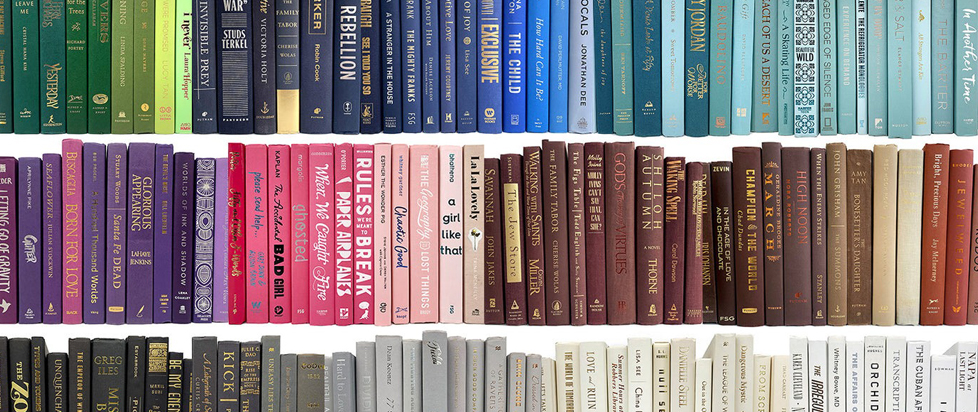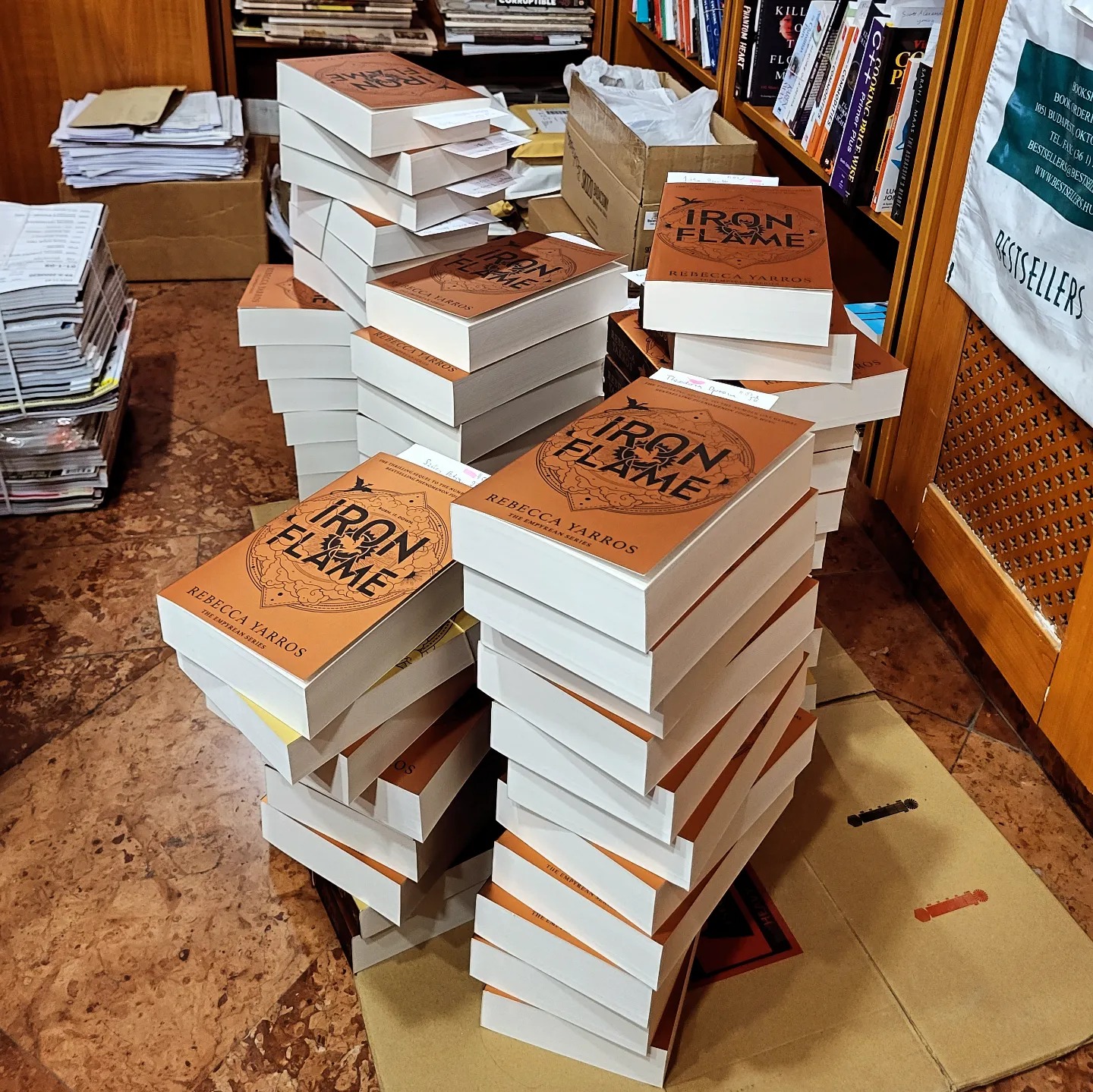
Shelf Fodder

This column is a reprint from Unwinnable Monthly #170. If you like what you see, grab the magazine for less than ten dollars, or subscribe and get all future magazines for half price.
———
Interfacing in the millennium.
———
The store I work at has begun to organize our BookTok shelf by color. It’s quite pleasant to look at; the cheerful cartoon covers with their colorblock backgrounds meld together into a nice harmonious display, flowing quietly through the rainbow, while next to them the romantasy and dark erotica stands out stark and black, making sure the reader knows they’re getting what they’re there to find. It’s a much better way to sell books, it turns out, than the classic genre-then-alphabetization. We’d damage the romcoms by relegating them to the romance section.
But the good news is these things move quickly. The intimidating popularity of BookTok’s latest darlings keeps them moving expeditiously in and out of our doors. I see the same girls within weeks staggering under their latest haul and then wandering in to sell them back, make more space for the newer, shinier, next big thing on their bookshelves.
I’ll be the first to emphasize the book as a consumer product. The sacralization of literature – the item, not the concept – becomes annoying at best when faced with just how much of our literary ephemera is garbage. Not content-wise, though that’s out there like all the others; the physical form of books, the space they occupy in the world and in our homes, is just as capable of collecting dirt and enduring wear and reaching the point of no return as any other object we have in our houses. There is absolutely nothing special about a paperback copy of The Kite Runner, or that Time 100 book that’s been sitting on your coffee table, or the dusty Jeff Shaara box set your dad swears he’ll read. Books are just things, like any other – they have the capacity to be important, enlightening, freeing, disturbing, just as they have the capacity to be mundane and unimportant.
That being said, trying to keep up with the speed at which they’re being spat out these days is exhausting. It seems like every day I’m running into a new edition of a book that wasn’t even that old sporting sprayed edges, a reversible cover, new epilogues, tipped-in fanart, or a less-than-convincing digital signature from an author I hadn’t even heard of before. You’ve barely bought your first thing before another thing comes along, this one shinier, this one harder to find, this one a-limited-edition-so-get-it-before-it-goes! You could be forgiven for forgetting that the thing was books one generally might be expected to sit down and read.

That’s the most important part of these trends, at the end of the day: the aesthetic. Color-coded shelves are basically a prerequisite for any acceptably hip booktube-or-booktokker. The literary It Girls sell products alongside their books like they’d sell brand name clothing, so that you don’t even have to tell someone about the book you’re reading for them to know about the book you’re reading. Chic cover trends assure that potential readers are correctly associating your book with its trendy progenitors, whether it be the swirling, abstract colors of memoir, the modern-text-over-classical-image of mainstream fiction, or the ubiquitous cartoon covers of contemporary romance. The predictability of the product is assured; you understand before you begin exactly what you’ll get.
This has always been the case in genre, of course. You come to James Patterson for one thing, Julia Quinn for another. But that’s about content – thrillers are thrillers, romances are romances – where this is about looks. At some point the marketers stopped selling new books to read and started selling new books to say you have read, whose contribution to the cause is their chameleon-like lack of distinctness, their total void of originality. They’re sold with tropes, generic names, cobbled-together backstories, resembling nothing so much as an endless cycle of self-serious Mad Libs.
An argument can be made for the liberatory potential of knowing what you like and giving people an escape in the throes of late capitalism. The argument has already been made that BookTok is by the girlies, for the girlies. But comfort food alone is not a balanced diet, and the implication that consuming schlock is a feminist act because – what? because women don’t want to read widely, to encounter new ideas, to have to think too hard? because reading was for men before we softened it, sexed it up, dumbed it down? – is stupid verging on offensive. Were we incapable of knowing what we liked until it was fed to us? Is this the most the modern woman should ask for? There is nothing progressive about parroting the company line. The company line, right now, is that you should buy their books.

The name on the tip of everyone’s tongue right now is Rebecca Yarros and her blindingly popular Fourth Wing series. The second book, Iron Flame, has been in the news for more than one reason recently. The snake has begun eating its tail. People are saying Yarros’ latest book has been written with AI, citing all sorts of things: the quality of the writing, forgotten plotlines, pacing issues, general incoherence. It’s impossible to tell for sure, of course, unless Yarros gets suddenly and uncharacteristically honest, which she has no incentive to do. The money’s being made, the books are being bought, the launch parties are being attended and discussed. Iron Flame sold out in bookstores across the world before anyone said shit about it being AI. And what does it say about our standards for writing and editing that now hundreds of people are looking at it with a critical eye and all we can say is that we aren’t sure?
In Ray Nayler’s great essay “AI and the Rise of Mediocrity,” he points out how AI by its nature is incapable of creating anything original: the entire scheme is that it can only create content through the composite parts that came before it, a “mash-up of old tropes” that “fill the world with grindingly average” products, media and pseudo-art. On the public’s side, it benefits greatly from the creation of a “replaceable consumer,” a “complacent buyer with reduced expectations of quality” who never asks for or expects anything better than “good enough.” Sound familiar? The faceless aesthetic and trope-logged, trend-obsessed churn has gotten us halfway there. Why demand originality or creativity when they look the same on the shelf as any other book, and demand more of your time – thus dragging down your Goodreads reading goal – to boot?
Hopefully the Iron Flame debacle means the bubble will finally burst. People are talking about BookTok and traditional publishing in the terms of fast fashion, now, realizing slowly that an infinite stream of replaceable objects is about as spiritually satisfying as Soylent. The capricious favor of the internet has turned on Yarros, and while I’m loath to celebrate sacrificing individuals to the voracious stomach of the social media machine, I’m happy I might finally stop hearing about her bad book. Then again, I doubt the death of the latest It Girlie will lead to the death of the It Girl. Someone else aesthetic and marketable will step in to take her place – or at least, aesthetic and marketable enough to keep the charade going, all this involved pageantry of choice that isn’t choice, wanting something you were told to want, liberation and freedom and representation through a sanctioned, sanitized product sold to you in hardcover for $28.99, to look pretty on the shelf next to all the others.
———
Maddi Chilton is an internet artifact from St. Louis, Missouri. Follow her on Twitter @allpalaces.




